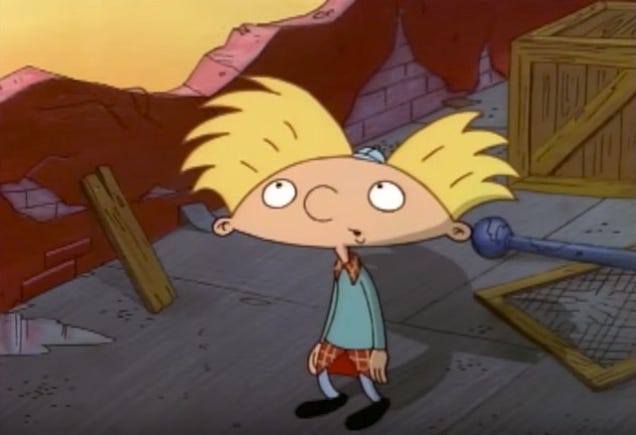
These days I watch my toddler nephews and nieces watch YouTube videos of adults unboxing and playing with toys for children, and wonder what level of the brain meme I’m living on. Sometimes I poke and probe—what could be interesting about this? Why is watching this more fun than playing with the very good, actual toys scattered below your feet?—but no matter how I frame it, no matter how I try to mush my inquiry into digestible bits, it’s too abstract a question for a child to grapple with. Who can say why they liked what they liked when they were five, while they’re five?
But the majority of it is terrible, and that much—the terribleness of what kid’s watch—is nothing new at all. Swap out the VHS tape for a retina display and the point still stands. Most of what gets funneled into the burgeoning American mind is awful, and as someone born in 1991 and as steadily affixed to the television as the average child of that era, I would never exempt myself from that. We watched bad TV. We watched unimaginative, gross, violent, lazy programming, most of which passed right through my system, as soluble and saccharine as cotton candy.
Advertisement
Almost none of it stuck with me. I am not here to argue that entertainment should be like eating vegetables, or should force-feed morality tales and multiplication tables down children’s throats, but good TV can really enrich a kid’s life: it can mold a sense of humor, etch a certain musical or visual sensibility, show them how to handle tricky situations that will arise in their lives, make them empathize with situations entirely removed from their own lives. Maybe I was watching all the wrong stuff, but the crushing majority of shows I watched did none of this for me. The dog conjoined to a cat, the irascible dam builders, the extreme-sports preteens—may you all be lost in the folds of history. You’re all useless.
But the one percent of that, the one drop that redeemed the remaining sewage, was Hey Arnold, and it’s coming back in movie form, and it is very possible that Nickolodeon will blow it, and that possibility is enough to weigh on my conscience.
Advertisement
Hey Arnold is a show about a soft-spoken, unerring do-gooder solving other people’s problems. That’s it. Watching him for a few minutes, only three things jump out at you: his head is a perfect prolate spheroid; he seems to be wearing a kilt in what is apparently late 20th century America (it’s actually just a long shirt peeking under his sweater); he sleeps, amid his grandparents’ seemingly middle-class apartment, in the most outlandishly technical bedroom you’ve ever seen—some real interior-design wish fulfillment for the preteen set, and still a high-water mark in my head.
Advertisement
At base it’s a show about a good kid. That’s it. It took feat of ingenuity to make this character’s life not just tolerable enough to waste an afternoon in front of, but also addictive and amusing and enduring in its viewers’ minds. The show gave me moral lodestars that I still consult, even though I haven’t revisited it in over a decade. Every so often I think about the one where Arnold learned karate, shook off his sedate nature and became some kind of cocksure smooth-talking operator, and I wonder: is there any story about the dangers of hubris as vivid as this one scene? Icarus has nothing on this. Watch as Arnold, all hopped up on physical confidence and Gorilla Mindset supplements, humiliates this well-intentioned, benign oaf:
It’s funny as hell, but it sticks in your ribs too, does a little knife-twist. The show was constantly doing this, which was its most basic trick: it delivered its lessons not from the clouds, like the worst and most heavyhanded kids shows, who trot out some constant voice of reason (a parent, a wizened elder) to spell out the moral of the story and tie up any ambiguous loose ends. You watched Arnold and figured out what was right and wrong just by reading the emotional states of—and naturalistic dialogue between—its likable characters, who were idiosyncratic but always relatable on some axis.
Its creators were constantly sketching pariahs who were wounded and weird—think Pigeon Man—without ever veering into the grotesque, forcing us to empathize with these people rather than gawking, which is perhaps a kid’s natural impulse. (Arguably the most toxic thing a children’s show can do, and that many of its contemporaries did, is feed that impulse.) They seeded little character gags—Harvey the mailman is constantly trudging through all kinds of weather, and he hates all of it; Stoop Kid can’t leave his stoop; Stinky stinks—without ever veering into overt caricature. Nearly everyone at the butt of a joke was also a real, well-rounded human being, who eventually earned an episode delving into their psyche. Even Helga, the consummate bully, was really a window, a way of showing children that even the crassest, most outwardly foul people have inner lives that are fragile and starry-eyed. Hillwood was a straight-up hive of humanity, and not just the tidy kids’ stuff—marital woes, jealousy, failing businesses, class consciousness, body image issues, even the long-unexplained orphanhood of Arnold himself.
Advertisement
Above all this Hillwood gave a suburban kid a gorgeous (and either utopian, or just totally obsolete) vision of city life, where everyone knew each other’s name and seemed to care about one another’s concerns. Well before the advances of corporate wokeness, we were served a diverse set of characters, with immigrants from Vietnam and the former Czechoslovakia, biracial best friends, rich kids and rubes, heads of all shapes. Hey Arnold was the purest thing my generation had, and if the nostalgia economy eats him up, and spits him out, football-shaped skull and all, I’d be tempted to forget every lesson he taught me and punch someone on the face. (Sorry buddy.)
SOURCE - DEADSPIN posted by Campus94Me


No comments:
Post a Comment